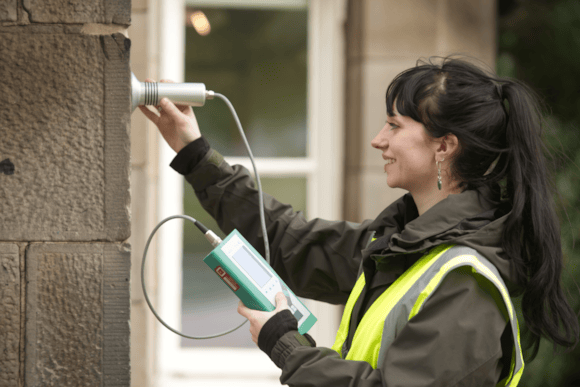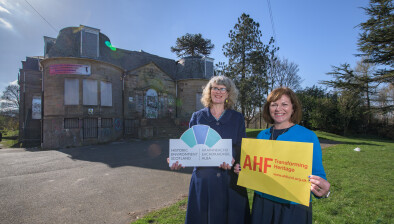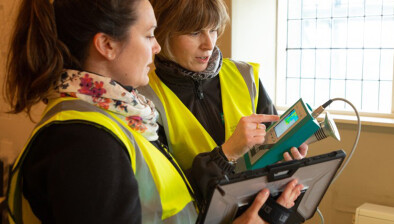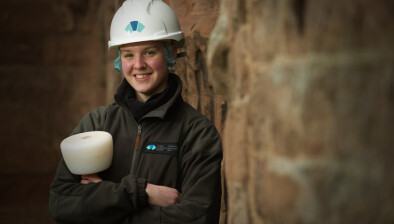HES to establish new national centre for retrofit of traditional buildings

Jasper Croser, heritage science lab assistant at HES, conducting a microwave moisture survey at Holyrood Park Lodge
Historic Environment Scotland (HES) has announced plans for a new dedicated national centre to champion the retrofit of traditional buildings to improve energy efficiency and play a key role in achieving national net zero targets.
HES has welcomed £1 million of funding from UKRI Arts and Humanities Research Council to establish the new hub, which will put heritage science and research at the heart of its approach to developing best practice for the retrofit of traditional buildings. As well as expanding HES’s technical research capabilities, the centre will focus on delivery of much-needed training and foster innovation in the use of low-carbon retrofit materials.
The Retrofit lab will support the development of bespoke solutions required for the decarbonisation of the historic environment, a crucial component of the transition to net zero. The retrofit interventions required to improve energy efficiency in modern buildings are often inappropriate for these traditional buildings, which require specific considerations around heat, moisture and airflow, as well as special care to ensure their cultural significance is maintained in the adaptation process.
Dr David Mitchell, director of cultural assets at HES, said: “We’re very pleased to welcome this funding, which will mark a step-change in our work to help improve the energy efficiency of traditional buildings. This infrastructure investment by AHRC recognises the role that the Engine Shed – our national building conservation centre - plays in supporting the stewardship of traditional buildings through heritage science and traditional skills.
“There is no route to net zero without viewing existing buildings as assets and ensuring we have a sound base on which to make retrofit work for both the buildings and the occupants. Without this understanding and expertise we could negatively impact the health of both buildings and occupants. The Retrofit lab will help us meet our objectives by enabling us to expand and enhance our research and training capacity. Collaboration will be key to our approach, from academic and commercial partners to local authorities and third sector organisations, as we work together to build best practice and develop the technical skills traditional building retrofit requires.
“Retrofit of our traditional buildings can bring many wider benefits if done properly to protect the special character of these buildings that give local places their unique identities. There are also huge potential economic benefits and new employment opportunities to be realised through ensuring our existing building stock is in a good state of repair and that retrofit measures are technically sound and effective. We have over 4000 years of traditional building experience in Scotland – our heritage and traditions are integral to our future success.
“The scale of the challenge ahead to meet national targets at the pace required will require an acceleration of efforts across all sectors, and the Retrofit lab will enable HES play its part to support retrofit and the historic environment’s transition to net zero while making a real and lasting positive difference to people’s lives.”
The announcement of the new national centre for traditional building retrofit comes as a recent survey by HES revealed strong support for retrofitting traditional buildings. The survey revealed:
- Respondents prioritised energy-efficient buildings, renewable energy and recycling for achieving net-zero goals, with 38% ranking retrofit, 38% ranking recycling and 44% ranking renewable energy as the most vital measures.
- Over three quarters (77%) of respondents are aware of the Scottish Government’s proposals to set minimum energy efficiency standards for privately rented homes by 2028, and for all homes by the end of 2033.
- Environmental benefits, increased efficiency and property value motivate retrofitting, with 37% citing environmental benefits and 34% citing an increase to their property value as reasons they would consider retrofitting their home or property.
- Despite the widespread recognition of the need and value of retrofit, the survey also found that 7 in 10 (70%) of Scottish respondents would be put off purchasing a traditional property because of the perceived barriers to retrofitting.
- Capital cost, access to funding and planning regulations are the main perceived barriers, with 29% citing capital cost, 24% citing access to funding and 23% citing planning permission / compliance with regulations.
- Green home grants and low-interest loans are seen as effective incentives to retrofitting, with 34% supporting grants and 29% supporting loans.
- Almost 9 in 10 (86%[5]) respondents said they would consider a green mortgage, which offers specific incentives for retrofitting such as lower interest loans tied to energy savings.
Commenting on the survey results, Dr Mitchell said: “The results of this survey show that while there is some concern regarding the perceived barriers to retrofitting traditional properties, people care about increasing the energy efficiency of these buildings and understand the importance of doing so in order to meet national net zero targets. People want to live in traditional properties and are becoming increasingly informed about using the correct skills and materials. We want owners to see past the ‘snake oil’ instant solutions appearing on the market and understand the benefits of traditional solutions combined with good science.”














